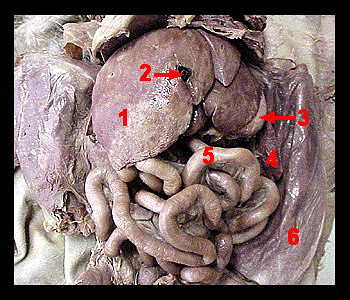|
|
||||||||||||||||||||||||||||||||||||||||||||||||||||||||||||||||||||||||||||||||||||||||||||||||||||||||||||||||||||||||||||
|
This image shows some of the major organs of the cat digestive system. The liver (which is the largest gland in the body) is situated beneath the diaphragm. Although the liver performs many vital functions in the body, its only role in digestion is the production of bile. Bile is a complex fluid containing bile salts, bile pigments, cholesterol and lecithin (a phospholipid). Bile salts function as an emulsifying agent, that is, they assist in the breakdown and absorption of fats. Bile leaves the liver via the common hepatic duct and enters the duodenum through the bile duct. When digestion is not occurring (i.e., between meals), bile is stored in the gall bladder, which lies in a depression on the surface of the liver. Note that interior of the abdominal wall is lined with an extensive, slippery serous membrane called the parietal peritoneum, which is continuous with the visceral peritoneum (serosa) that covers most of the digestive organs (seen as a shiny covering on some of the organs). |
|
